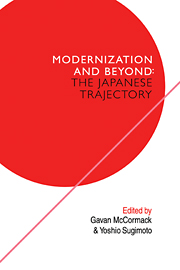Book contents
- Frontmatter
- Contents
- Contributors
- Introduction: modernization and beyond
- I Popular culture: tradition and ‘modernization’
- II Popular movements: alternative visions of ‘modernization’
- III Uneven development and its discontents
- IV Sex, politics and ‘modernity’
- V ‘Modernization’ and ‘modernity’: theoretical perspectives
- Glossary
- Index
Introduction: modernization and beyond
Published online by Cambridge University Press: 04 August 2010
- Frontmatter
- Contents
- Contributors
- Introduction: modernization and beyond
- I Popular culture: tradition and ‘modernization’
- II Popular movements: alternative visions of ‘modernization’
- III Uneven development and its discontents
- IV Sex, politics and ‘modernity’
- V ‘Modernization’ and ‘modernity’: theoretical perspectives
- Glossary
- Index
Summary
JAPAN AND MODERNIZATION THEORY
Historians, sociologists, and political scientists continue to debate the fine points of what it means for a society to ‘modernize’, even as they agree that the so-called advanced countries have now completed the process and begun to move into the even more unknown territory ‘beyond modernization’. Western social science theory for long understood ‘modernization’ as a basically unilinear process of transformation of the world which stretched from the cultural and intellectual world of seventeenth-century Europe to the post-1945 United States; the Japanese experience was never easily incorporated within such a model, and the emergence of Japan as an economic superpower calls the whole theory in question. Likewise the theoretical extension of the ‘modern’ trajectory into the ‘post-modern’ will remain unsatisfactory so long as such theorization remains exclusively Euro-American oriented.
As the first society outside the Western cultural tradition to achieve a high level of industrialization Japan was, and still is, the crucial case for the debate over whether industrialized societies have a tendency to become increasingly alike in structure and values – the socalled convergence debate. In the context of Japanese studies, there are two further interrelated problems. Is modernity to be defined by Western, Japanese or universal (and somehow culturally neutral) standards? And however the concept is defined, does Japan qualify as ‘modern’?
As Japan develops into an economic superpower, whose trade performance appears to threaten other industrialized societies, it has become common to suggest that it is the country which others must emulate.
- Type
- Chapter
- Information
- The Japanese TrajectoryModernization and Beyond, pp. 1 - 14Publisher: Cambridge University PressPrint publication year: 1988
- 4
- Cited by

